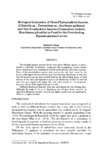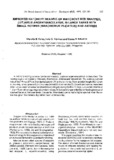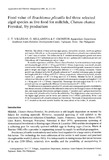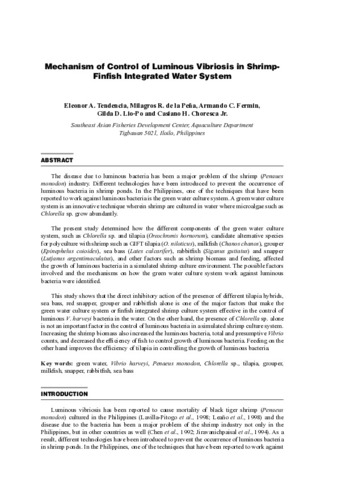Biological evaluation of three phytoplankton species (Chlorella sp., Tetraselmis sp., Isochrysis galbana) and two zooplankton species (Crassostrea iredalei, Brachionus plicatilis) as food for the first-feeding Siganus guttatus larvae
- Global styles
- MLA
- Vancouver
- Elsevier - Harvard
- APA
- Help

View/
Date
1986Author
Page views
4,180ASFA keyword
AGROVOC keyword
Taxonomic term
Metadata
Show full item record
Share
Abstract
First-feeding Siganus guttatus larvae were given different species of phytoplankton (Chlorella, Tetraselmis, Isochrysis) and zooplankton (oyster trochophores, Brachionus) or a combination of both on the first day when they can feed. None of the phytoplankton species when used as the only food source for the larvae could support life beyond four days from hatching. Brachionus of sizes less than 90 microns was the most suitable food for the first-feeding larvae. A food mixture of the three phytoplankton species and Brachionus resulted in survival rates that were significantly higher than with other treatments. Larval growth, however, did not differ significantly (p>0.05).
Different Brachionus densities were also used during the first-feeding days. Although the range of 10 to 15 Brachionus per ml gave better survival, no significant difference existed. Growth was slightly greater but not significantly different at higher densities.
Description
Contribution No. 196 of the Aquaculture Department, SEAFDEC.
Suggested Citation
Duray, M. N. (1986). Biological evaluation of three phytoplankton species (Chlorella sp., Tetraselmis sp., Isochrysis galbana) and two zooplankton species (Crassostrea iredalei, Brachionus plicatilis) as food for the first-feeding Siganus guttatus larvae. The Philippine Scientist , 23, 41-49. http://hdl.handle.net/10862/1180
Type
ArticleISSN
0079-1466Collections
- Journal Articles [1256]
Related items
Showing items related by title, author, creator and subject.
-
Improved hatchery rearing of mangrove red snapper, Lutjanus argentimaculatus, in large tanks with small rotifer (Brachionus plicatilis) and Artemia
Duray, Marietta N.; Alpasan, Lota G.; Estudillo, Chona B. (Society of Israeli Aquaculture and Marine Biotechnology, 1996)A hatchery rearing scheme for the red snapper, Lutjanus argentimaculatus, is described. The feeding regime consisted of Chlorella, Brachionus, Artemia and minced fish. The average survival rate at day 24 was 27% in 3-ton ... -
Food value of Brachionus plicatilis fed three selected algal species as live food for milkfish, Chanos chanos Forsskal, fry production
Villegas, Cesar T.; Millamena, Oseni; Escritor, F. (Blackwell Publishing, 1990)The effects of three selected algal species, Tetraselmis tetrahele, Isochrysis galbana and marine Chlorella sp. on the population growth of Brachionus plicatilis was evaluated after 3, 5 and 7 days of culture. The rotifers ... -
Mechanism of control of luminous vibriosis in shrimp-finfish integrated water system
Tendencia, Eleonor ; de la Peña, Milagros R.; Fermin, Armando C.; Lio-Po, Gilda D.; Choresca Jr., Casiano H. (Aquaculture Department, Southeast Asian Fisheries Development Center, 2005-03)
The disease due to luminous bacteria has been a major problem of the shrimp (Penaues monodon) industry. Different technologies have been introduced to prevent the occurrence of luminous bacteria in shrimp ponds. In the ...
; de la Peña, Milagros R.; Fermin, Armando C.; Lio-Po, Gilda D.; Choresca Jr., Casiano H. (Aquaculture Department, Southeast Asian Fisheries Development Center, 2005-03)
The disease due to luminous bacteria has been a major problem of the shrimp (Penaues monodon) industry. Different technologies have been introduced to prevent the occurrence of luminous bacteria in shrimp ponds. In the ...





